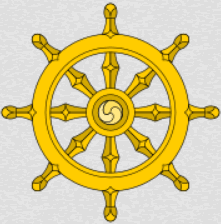BUDDHISM, WHEELS and REPETITIONS
Pleasure and wanting lead to repetitions.
Once the repetitions start, they keep repeating.
____________
Buddha's central teachings are the Four Noble Truths. The Mahāsatipaṭṭhāna is the most detailed version of the Four Noble Truths, in the original Pali scriptures. This essay is based on the Mahāsatipaṭṭhāna Sutra (DN.22).
The first three Truths are about Dukkha (Pali), its beginnings and endings. The Fourth Truth is a list of instructions and directions – in the Mahāsatipaṭṭhāna the first of these instructions is specifically: The Right Understanding of Dukkha. These days Dukkha is commonly understood as 'suffering'.
The First Truth
 In Buddha's time the word Dukkha was used to describe when a wheel was not turning smoothly on its axle. The spoked wheel dates from around 2,000 B.C.. By 500 B.C., when Buddha was alive, the wheel had led to a Cultural Revolution.
In Buddha's time the word Dukkha was used to describe when a wheel was not turning smoothly on its axle. The spoked wheel dates from around 2,000 B.C.. By 500 B.C., when Buddha was alive, the wheel had led to a Cultural Revolution.
In those days, this new invention of rotary motion and the wheel, was the epitome of continuous repetition and self-perpetuating motion.
There was one big central problem : Dukkha. In those days the wheels squeaked and wobbled, and the hub needed constant maintenance in order to run smoothly.
Dukkha describes how our existence is not running smoothly. The hub of the ancient wooden spoked wheel symbolises how life wobbles, and sometimes starts grinding or gets twisted and blocked.
Modern suggestions for the interpretation of Dukkha are : suffering, anxiety, distress, unsatisfactory, frustration, unease, stress(1); – all may be true, but none express the sense of repetition and self-perpetuating motion as witnessed in the wheel – not running smoothly, not turning well.
There is another symbolism to the old-fashioned cartwheel which would have been obvious to anyone living in those days : the hard wheels on the soft dirt roads made tracks, habitual ruts, karmic ruts.

The 17th century invention of the ship's wheel has a totally different use, and functions in a totally different way, to the spoked wheel of Buddha's times.
The use of the ship's wheel on many Buddhist websites, including the English Wikipedia page on Dukkha(1), exemplifies how far modern Buddhism has diverged from the original teaching.
What is Dukkha? What is not running smoothly?
In many texts it is written that the Five Aggregates are Dukkha. The Aggregates are five umbrella terms which explain how we experience the world. They describe the process: manifest form, sensation, perception, concepts and consciousness. The Aggregates apply to all of our senses. Our sensory apparatus is not running smoothly
In Buddhism, where thoughts are considered as manifest forms or 'mind-objects', the Aggregates also apply to how the mind senses its own thoughts. In other words, the mind sensing thoughts, functions in the same way as the eye sees a sight, or the ear hears a sound.
The First Truth tells us very simply: Our sensory apparatus is not running smoothly; or –
Our sensory apparatus, the Five Aggregates which are manifest in the six senses of touch, taste, smell, sound, sight and thought, are not running smoothly.
The Second Truth
The normal view is that Buddha adopted the Hindu idea that pleasure and wanting lead to attachment, and then he added the new idea that due to impermanence and change, attachment leads to suffering.
I believe Buddha's new central idea (or one of them), was that pleasure and wanting lead primarily to repetitions. Simply: if something is pleasurable, we want to repeat it. Repetitions involve us in a timeline, they are not conducive to being now. And, once the repetitions start, once the wheels start turning; then they turn with their own karmic momentum.
Repetitious wanting causes endless 'next things to do' and a mental feedback system, which one translation gives as "The rolling in thoughts of mind objects"(2). The origin of Dukkha is the ever-increasing complexity, and conflicting directions between all the different types of repetition.
The traditional view that attachment is the central problem, is supported by the fact that the Five Aggregates are almost always and only defined in terms of "the Five Aggregates of Clinging". 'Clinging' limits their interpretation and their potential as a universal theory. Attachments, especially extreme attachments like clinging, are just one of the possible consequences of the repetitions.
The Aggregates primary attribute is repetition, and once set in motion – once the wheels start turning –, the mind starts sensing its own thoughts, and then they keep repeating.
The extreme forms of Dukkha: suffering, clinging and craving; make Buddha's message more concrete and dramatic, but they diminish its universal application.
I believe Buddha's message applied to all the little wants and problems we have, like the times we end up in the kitchen and forget what we came for.
There is another important word in basic Buddhism: Sukkha. Sukkha means when a wheel is running smoothly. A good wheelwright would not only be able to cure Dukkha, he would know how to make a wheel Sukkha.
Buddha found the answer to fulfillment in life, not only the answer to suffering. Buddhas's message about Dukkha, was about far more than just suffering.
This way of understanding Buddha's prime-truths, started when i read : the origin of Dukkha is "that craving which gives rise to fresh rebirth" (3) – and realised the simple everyday sense of is : "that wanting which leads to another repetition".
It may well be that extreme forms of wanting like craving, lead to extreme forms of repetition like rebirth; but it is obvious that even the smallest want we have, will lead to some form of thought, if not actual repetition, and this is a basic universal truth.
If pleasure and wanting lead primarily to repetition, and not directly to attachment, this modifies much in the modern understanding of Buddhism.
References
Ref. 1, https://en.wikipedia.org/wiki/Dukkha 2019, Ref. 2, Pali Tipitaka, Vipassana Research Institute, Mahāsatipaṭṭhāna Sutra https://www.tipitaka.org/stp-pali-eng-series#42 (last paragraph before #43 ). Ref. 3, Nyanaponika Thera, "The Heart of Buddhist Meditation" (page 142) Rider & Co. London (1962). Ref. 4, Mahāsatipaṭṭhāna Sutra Collected Translations (English, French, German).
Please continue with Buddhism and The Middle Way
See special Buddhist Index for further discussion of Dukkha and "suffering"